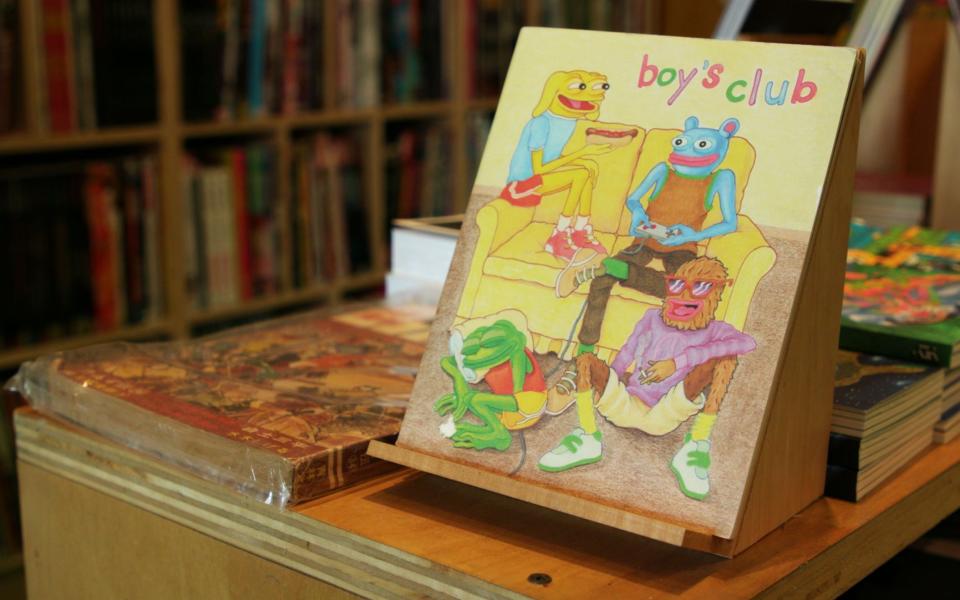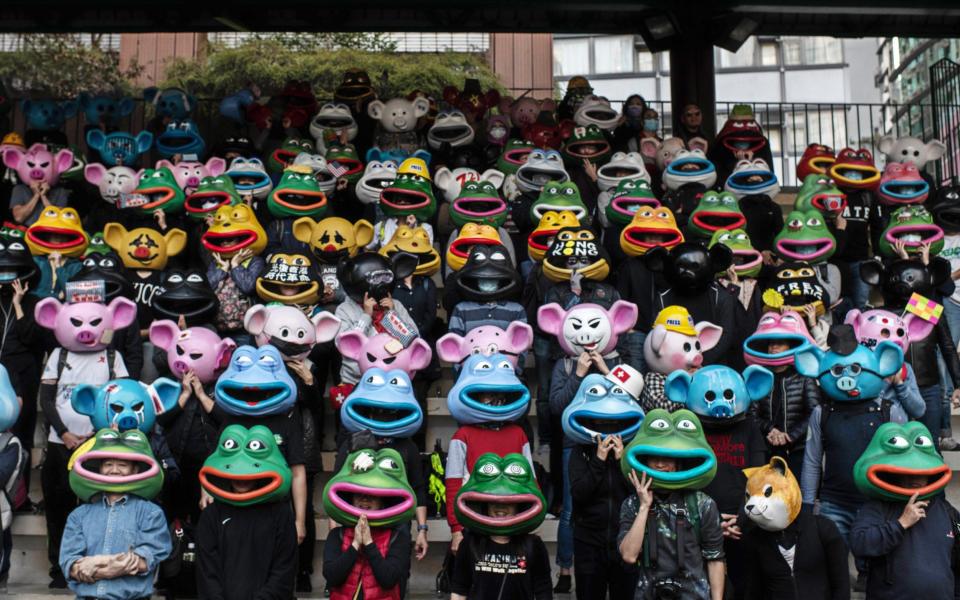Pepe the Frog: how a mild-mannered cartoonist accidentally created an alt-Right hate symbol

It says a lot about internet culture that the most political online symbol of the last 10 years is a small, stoned frog called Pepe. You might not recognise the name, but you’d probably recognise Pepe the Frog’s goofy, half-stoned eyes, his wide, expressive mouth rendered in rudimentary Microsoft Paint style and bright primary colours.
One of the most divisive and confused cartoons of the digital age, Pepe's image has been used in every political corner you can think of. You might have seen Pepe on gushing tweets promoting world peace and climate change, but you might have seen him fronting racist tirades by the alt-Right and at anti-BLM demonstrations saying that All Lives Matter. While he’s been the face of pro-democracy protests in Hong Kong, he's also a mascot for neo-Nazis. He even played a fairly key part in the election of Donald Trump to the US Presidency.
Tonight, however, you'll see Pepe back in the hands of his original creator. A new BBC4 documentary, Feels Good Man, aims to shed light on how a sweet little cartoon frog turned into one of the most disturbing symbols on the internet.
Pepe was created in 2006 by then 20-year-old San Franciscan cartoonist Matt Furie for his comic book Boy's Club. With sharp black humour, the comic traces the psychedelic adventures of teenage Pepe and his mischievious roommates Andy, Brett, and Landwolf, who were more interested in taking drugs than taking in school. It instantly became a stoner classic for the Tumblr generation.
Pepe then took off as a meme after Furie started posting pictures of him onto MySpace, and by 2008, Pepe was all over popular chat forum 4chan: lovingly and innocuously remixed in different comic situations, moods and guises to suit the humour at hand. Pepe became so ubiquitous he even popped up on the Twitter timelines of pop stars Nicki Minaj (with Pepe dancing in a tight pair of shorts) and Katy Perry (with a meme about jet lag). Pepe was a symbol of hippie freedom and unity as well as happy-go-lucky fun. His catchphrase was: “Feels good, man.”
By 2010, however, Pepe was not feeling good. The meme had made its way into murky internet forums frequented by bigots, manipulated into memes that were either racist, sexist or anti-Semitic. By 2017, Pepe was dead: killed off by Furie to quash the alarming and at times dangerous political weaponisation of Pepe his creator could never have anticipated.
When I speak to Matt Furie over video call, he is remarkably zen for a man who has had to discuss a drawing of a frog for the last 15 years. Who, during the documentary, appears defeated and anxious as he fights to reclaim his creation. But there is none of that weariness now.

“A guardian angel gave me Pepe to spread love through the world. So yeah, in my heart, I've always felt Pepe had something to say,” he tells me, displaying a hippyish approach to life that his home city of San Francisco was known for before Big Tech moved in.
In 2005, Furie was working in the San Francisco Community Thrift Store in the arty Mission district of the city. Though the tech billionaires were slowly taking over, the Mission still retained some of the city’s hippie roots. In the back of the cavernous charity shop, Furie had a small, cramped office lined with toys and strewn with coffee cups, his sketches pinned up on the walls. Whenever he had a quiet minute in this tiny toy department, he’d be drawing and the guardian angels would be watching. The energy and style of the playthings around him infiltrated his work. Furie was enjoying the last flush of a life free from adult responsibility; he’d party, he’d work and he’d draw.
“Frogs are just kind of like a thing I've always drawn. Pepe in particular is more reflective of my twenties lifestyle,” he tells me. “Kind of like a post-college, kind of aimless, kind of a hedonistic party kind of lifestyle. He was just a chill guy that liked smoking weed and playing videogames.” This part-autobiographical amphibian ate pizza, hung out with his friends and liked to go to the toilet with his bottom on show. Furie named him Pepe “because it sounds like Peepee”, which goes to show the level of humour the comics were operating at.

It was 2005, so he uploaded those early comics to his MySpace page. Titled Boys Club, there were four main characters in the strips based on Furie and his friends but Pepe caught people’s imaginations from the off. Gym bros posted his slogan after a work out, people imposed the text on pictures of dogs hanging out the car window – Furie’s own favourite is the slogan pasted on a picture of John Goodman. It was all pretty harmless stuff, funny pictures and iterations of Pepe that his friends would send him long after he took down his MySpace page. “I said early on during the controversy that all things change, and the Pepe thing is going to change. And I still hold true to that.”
Furie then concentrated on other things: Boys Club was now in print and he was less interested in being online – even now he steers clear of most social media. “I think I've always been kind of wary of sharing stuff online. You know, I like to share it but I just don't like the way it functions.” He was aware that people had vectorised his original Pepe line drawings and were remixing him into new situations, and that one of his own iterations (Sad Pepe) had found a particularly warm welcome on the notorious message board 4chan.
Sad Pepe had become an emblem for the anonymous dropouts and losers on the board; those who’d moved into their parents’ basements, stagnated there and were proud of it. He was baffled by the emergence of Sad Pepe as the main Pepe. “In my early comics there was only one instance where he's sad. And I remember drawing that and trying to make him really sad. And it was over a pizza bagel. He was sad that he was eating this crappy food. And then it just kept mutating and evolving,” he says.
Both in the film and in person, Furie seems blasé about these early Pepe remixes. The only thing that really bothered him at this point was that Pepe was the only work he was ever asked about. But something was happening without him knowing: celebrities and “normies” cottoned on to 4chan’s Sad Frog images and began posting Pepe on Twitter and Instagram, and the message board users became irate. This was their thing, their culture, the iconography of their way of life, and it had become, they felt, corrupted. Their reaction was to corrupt the meme itself: thus Angry Pepe was born, and he was as offensive and undesirable as possible.

Users began posting pictures of Pepe wearing swastikas and committing atrocities, turning him from a harmless cartoon into a hate figure. In 2014, when Elliot Rodger killed six people near the University of California, Santa Barbara, people on 4chan began using Rodger and Pepe in memes together, depicting “heroic” scenarios. Some memes even had Pepe plotting about the Twin Towers. There were so many racist and offensive memes created featuring Pepe that Furie can’t even keep track of when he first heard about it. He was devastated by how his work had been corrupted.
But publicly he tried to downplay it, deflecting attention with insincere responses. “I never really engaged on 4chan, but I did kind of, early on when journalists would reach out to me, I would kind of give them troll-y answers,” he says now. “I’d be overly optimistic and positive about things in a kind of sarcastic way. That was just my way of dealing with the attention and to try to downplay the negativity.”
But things got worse with the creation of Smug Pepe (Pepe stroking his chin with a knowing look in his eye). The documentary eloquently details how Pepe became a symbol of the alt-Right and a picture of Smug Pepe with Donald Trump’s haystack hair was famously tweeted by Trump himself during the 2016 election campaign. The users on 4chan, whose politics were veering venomously right, felt they had memed Trump into office.
It was, as executive producer Giorgio Angelini puts it, “a really confounding moment for people to try to understand.” It wasn’t just “whatever Trump represented in 2016”, it was also how we were reckoning with the internet’s impact on everyday life. “The moment where internet fictions seeped into reality and mixed everything up. And we're still very much feeling the reverberations of that moment,” he adds.

The Matt Furie you see in the documentary is an increasingly strained man; it’s almost as though he didn’t realise how bad things had got. The pain of having Pepe included in the Anti-Defamation League’s dictionary of hate symbols is written all over his drawn face. “Something about that movie that struck me was how emotional I am,” he says now. “I didn't realise how emotional I was until I saw the movie.” When he begins legal proceedings against Alex Jones, head of InfoWars and alt-Right big wig, for selling a poster with Pepe alongside other Right-wing figures (Milo Yiannopoulos, Kellyanne Conway), his answers are clipped and he seems like a man fighting to stay calm. Jones, by contrast, is all bluster and indignation: he eventually settled out of court for $2 million.
There were times, Furie says, where he wanted to stop drawing altogether. He was mercilessly trolled for a sweet but misguided hashtag campaign to #SavePepe, where he invited people to create their own happy frogs. “It was more kind of therapeutic for me to... you know, I didn't really know what to do in the situation,” he says. “But also it set it up to be trolled pretty easily. Even while I was doing it, I was talking with my wife, Aiyana, and she's kind of cringing, like, this is not gonna do anything. It's not gonna work. But I don't know. It was better for me to do that than to just be angry – that’s how I dealt with it.” Eventually he tried killing Pepe: but even that proved yet more fodder to the trolls.
“We kept the making of the film extremely quiet,” says director Arthur Jones, who approached Furie about making the documentary (Jones's debut) when Pepe became a hate symbol in 2016. Furie says he wasn’t bothered by some of the threats he received (including an image of him having his head cut off) but I don’t quite believe him. “We definitely did not broadcast that we're making the Pepe the Frog film... we wanted to avoid any potential negativity, because I think this was a story that both people on the left and people on the right would assume that either we would get wrong, or maybe they didn't need to be told.”
They’d expected it to be difficult to get someone from 4chan to talk, and someone from Trump’s digital team, but in fact it was the experts in the field of online trolling who were the most reticent to go on camera. The reaction has been largely heart-warming; Jones, Furie and Angelini are all glowing as they show me new Pepes that people have sent them from all over the world.
Matt Furie with a great single page send-off. #freecomicbookday #mattfurie https://t.co/lKGUL9lmyd pic.twitter.com/qhngOyoVPV
— Brandon Kelly (@therealphaTT) May 6, 2017
Despite the gravity of the subject matter, there are moments of humour in Feels Good Man where the sheer absurdity of the situation shines through. And Furie says he can appreciate the dark with the light. “I think negative stuff in, you know, seeing a corpse rotting with maggots all over it can be just as inspirational as a rainbow and a beautiful cloud that's about to burst into rain. Like, you need the rot of life to grow the flowers.” There’s a pause as everyone tries to figure out what to do with that image, and Jones quips: “Matt’s both a hippie and a goth.”
Furie isn’t afraid of the trolls any more, if he ever really was. He seems to have finally come to accept that Pepe will continue to morph into new iterations and to try to control it is a Sisyphean endeavour. And in fact, positivity has rolled around again. Sad Pepe became the unlikely symbol of the Hong Kong pro-democracy protests last year, and is now the most popular reaction emoji on Twitch. “So yeah,” he says. “No regrets.”
“I think everything happened for a reason. I think we're all on a path. We are our own paths in life.” He pauses. “The only regret I have in life is not bungee jumping. And I can still do that.”
Feels Good Man will be shown on BBC4 on October 26 at 10pm, and will then be available through iPlayer

